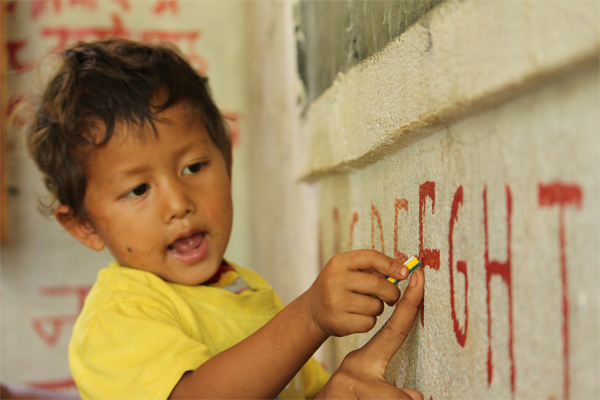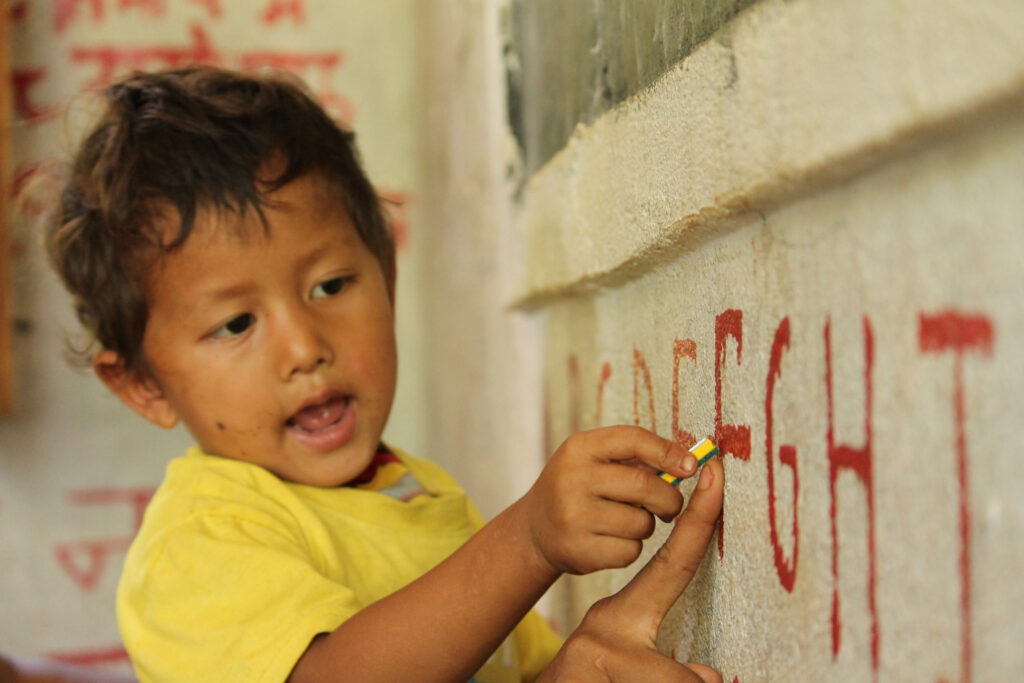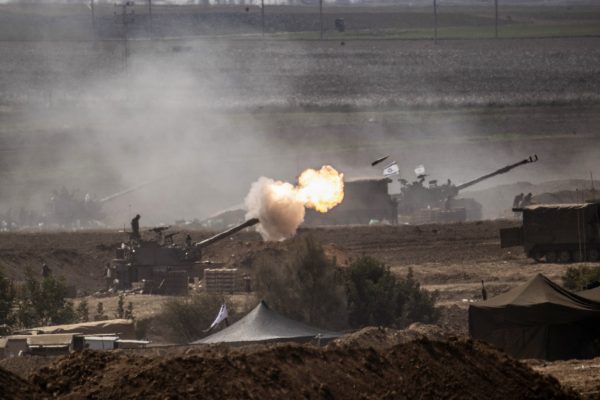
Photo courtesy of World Bank Photo Collection
At the school in Nepal’s Lalitpur district where I work as an English teaching assistant, a large and colorful mural proclaims: “The world is a lock. Education is the key.” For Nepalese students today, though, the key is not so much education in general as competency in the English language, in particular.
“Now this world is like one country,” says Rupchandra Gopali, vice principal and English teacher at the school. “English is one medium that can be used in every country, whether people know other languages or not. If they know English, they can do jobs everywhere.”
For more than four decades, private schools in Nepal have offered English, rather than Nepali, as the language of instruction. Although English was accepted as one medium of education as far back as the country’s 1971 Education Act, the shift toward private, English-only schooling has intensified over the last generation—particularly in the Kathmandu Valley, where parents are more likely to be able to foot the bill. There are about 1,500 private and only 600 public schools in this area—a striking departure from the distribution in the country as a whole, where fewer than 20 percent of the over 35,000 primary and secondary schools are privately run.
The trend poses a problem for local public schools. Since government school funding in Nepal depends on enrollment, losing students means a tighter budget, and should numbers fall too low, schools may be merged or simply closed. Public schools are up against a widespread belief that private institutions offer higher-quality education, a perception that has much to do with testing results: around 80 percent of the students who pass the School Leaving Certificate (SLC) exams, administered at the end of tenth grade, are private school enrollees. In a bid to stem the tide of departing students, some community-run schools have started teaching in English, which is assumed to mean better education by dint of its long association with higher-performing private institutions. For parents, the shift offers an attractive option: the same leg up ostensibly offered by private schools, with minimal or no fees.
Yet the decision to change the language of instruction introduces significant complications. Many public school teachers themselves have only a fairly basic background in English, and the Nepali government cannot guarantee additional training to close the gap.
• • •
Ramesh Prasad Ghimire works in the Ministry of Education’s Curriculum Development Centre, the government branch responsible for developing a national curriculum and monitoring the quality of privately published reference books. When we spoke recently, he explained that the government is not able to jump in and retrain teachers whenever a school switches its language of instruction. Some programs, such as a recent venture with the British Council to train primary school teachers in English, will help if schools decide to make the switch to English—but usually they must handle any retraining themselves, with their own English teachers or the help of an NGO or INGO. “The government cannot—and should not, I think—decide the language,” Ghimire said. “There are different educational contexts.”
My school advertises itself as English-medium up until grade seven. In reality, most teachers I have observed still conduct their classes largely in Nepali. Especially as the students advance and subjects become more complicated, the lack of a solid foundation in English makes its consistent use practically impossible. Nevertheless, our texts and assessments are all in English: in order to teach to the test—the predominant arbiter of academic success in Nepal—explanations and directions are in one language, while the target knowledge is dispensed in another. Teachers thus often devote their time to rote call-and-response, helping students memorize key phrases within the textbook rather than delving deeply into the topics at hand.
Children not only learn better when taught in their native language, but are more prepared to participate in society.
Shyam Sharma, an assistant professor of writing and rhetoric at Stony Brook University, frequently inveighs against the English-medium trend, arguing that it merely intensifies the testing focus by forcing students to memorize facts and phrases rather than learn critical thinking or composition skills. Before moving to the United States, Sharma taught for seven years at private English-medium schools in Nepal and lectured for another seven years at Tribhuvan University in Kathmandu. When I spoke with him by phone in September, he explained that English-only instruction often becomes an unnecessary burden on students and teachers alike.
“I’m not against English,” Sharma said. “I’m not against making our students proficient in English. I’m against the stupid idea of teaching social studies and science in English, especially when the poor teachers can’t speak it fluently.”
Some effects of the English-medium system are readily apparent. Many younger kids in my classes can sound out English words faster and more accurately than Nepali words—without, however, much comprehension. Most have an interest in someday traveling to an English-speaking country. There are obvious drawbacks, too: my students’ parents often have little to no knowledge of English themselves, so children are unable to ask for help with most of their homework. And learning in a non-native language is just plain difficult, especially when children are too young to have developed independent study skills. Few of my students have the instinct to work through problems on their own if they don’t understand them right away; instead, hands shoot up amidst a chorus of “Miss! Miss!” This only reinforces the focus on rote learning. They are used to having a right answer, and guessing or approximating is not typically rewarded.
But these difficulties are not unique to schools that teach in English. Children attending public schools of any medium in Nepal face significant challenges. Many community schools, low on funds, lack the resources to integrate visual aids or extracurricular activities with classwork. Tests, too, are an enormous source of pressure: from first grade on, tri-yearly exams take up a huge amount of time and energy. Faced with chores or family responsibilities at home, some students—especially girls—come to school rarely, if at all.
• • •
Many studies suggest that teaching students in their native language leads to better educational outcomes. Research conducted by UNESCO makes the case that children everywhere learn better—in all subjects, including additional languages—when early education, up to six or eight years, is conducted in their mother tongue. Michel DeGraff, professor of linguistics and philosophy at MIT, has done extensive education research in Haiti, where French is the dominant language of instruction but most Haitians speak Kreyòl. He argues that children not only learn better when they are taught first in their native language, but that they are also more prepared to participate in civil society.
In fact, education policy in Nepal has allowed for mother-tongue instruction since 1971. Nepal’s last census—in 2011—recorded 123 native languages; less than half the population speaks Nepali first. The School Sector Reform Plan 2009–2015 declared that children had the right to education in their first language at least until grade three, and Nepal’s 2015 constitution reaffirmed that “every Nepali community living in Nepal shall have the right to acquire education in its mother tongue up to the secondary level.” Yet the choice for which medium to use ultimately rests with local school management committees. A right is not a guarantee, particularly in cases where community leaders decide that a different course of action will be more beneficial.
Some communities are pushing for mother-tongue education as an alternative or a precursor to English-medium. According to Ghimire, the demand is fairly recent—he sees it as part of a growing awareness about the rights of different ethnicities and minorities. These communities seek to preserve culture through their languages, which are marginalization by an official reliance on Nepali and, increasingly, English. In fact, in response to requests from community members, the government has prepared textbooks for around twenty-five non-Nepali mother-tongue languages.
Even communities that introduce these programs feel the simultaneous tug of English, though. A 2014 study carried out in thirteen Kathmandu Valley community schools that were implementing mother-tongue instruction in the early grades found that parents generally supported the policy but worried that the program would deprive children of opportunities in the international arena.
• • •
Nepal’s education system is very young. Before 1950, public education in any language was available only to citizens who were high-caste or of the elite. In terms of access, huge strides have been made in a relatively short amount of time: by 2014, 97 percent of eligible children in Nepal were enrolled in primary school, according to the Asian Development Bank. English has been an influential factor since the inception of Nepal’s education system: British citizens were brought in to educate elites in the early twentieth century; Nepal’s first university initially conducted all its courses in English. The language has, accordingly, spread along with education itself, and its introduction has steadily trended younger. Gopali, the vice principal, said that when he was in school English was not introduced as a subject until grade four. By contrast, since 2002, English as a subject has been compulsory from grade one onward.
The push for English-medium, however, is not a top-down dispensation: it is coming from within communities, driven by parents and guardians who want their children to be proficient in English. Such a desire is certainly reasonable: particularly for those living near large cities or within the Kathmandu Valley, many of the most prestigious—and lucrative—career paths available to young people involve English.
"It’s become a roadblock in everybody’s life, except for those with enough money. I don’t know why we do this to people.”
More and more Nepalese are leaving the country to work and study abroad. In 2015, according to the World Bank, personal remittances made up a staggering 32 percent of the country’s GDP. That same year, the World Travel & Tourism Council reported that the direct contribution of tourism accounted for another 4 percent of the GDP. In addition, in 2014–15, over 29,000 students signaled an intention to study abroad. As of 2011, nearly 14 percent of the country’s youth were living in other countries for employment or education. Since these numbers only reflect the number of citizens who do end up leaving the country, they are likely underestimates of those who seek to leave, especially given that competition for visas is fierce.
Not everyone heads to English-speaking countries: Persian Gulf countries, Malaysia, and India are also popular destinations for work, and Japan rivals Australia and the United States as a study locale. Likewise, Indian and Chinese tourists outpace Americans. Nonetheless, there is a perception among the Nepalese that English, compared to other languages, is more useful in more places—the ticket to more opportunities and a better life.
Sharma calls this a sentimental view of English. In his view, people feel strongly about the language, associating it with success and prestige; the larger implications of its use in society, and schools especially, are not given enough consideration. Labeling English a language of opportunity is overly romantic, he said, when it increasingly functions as a barrier to social mobility in Nepal. “People should acknowledge that it’s a language of opportunity—for people who are already privileged,” he said. “[Other] people are failing all the time. It’s become a roadblock in everybody’s life, for everyone except those people with enough money. . . . I don’t know why we do this to people.”






